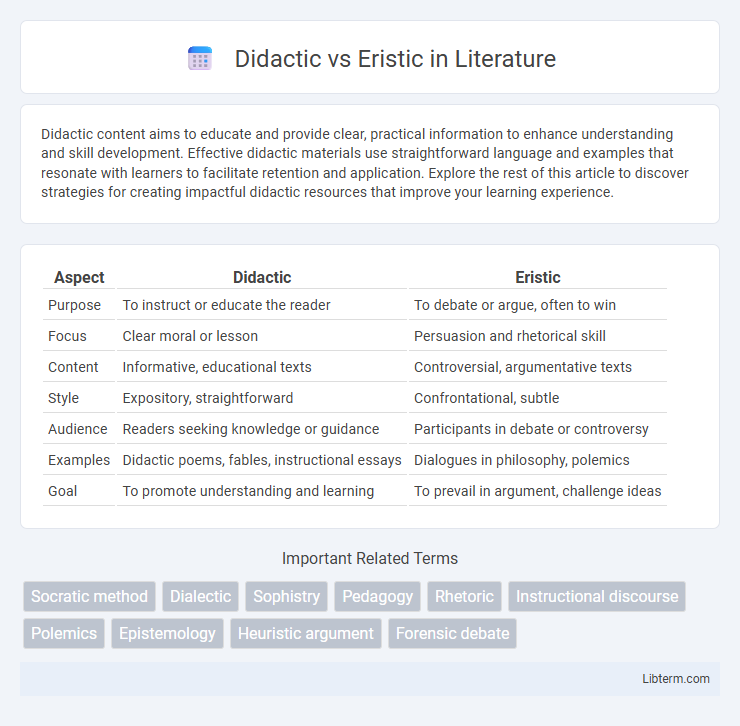Didactic content aims to educate and provide clear, practical information to enhance understanding and skill development. Effective didactic materials use straightforward language and examples that resonate with learners to facilitate retention and application. Explore the rest of this article to discover strategies for creating impactful didactic resources that improve your learning experience.
Table of Comparison
| Aspect | Didactic | Eristic |
|---|---|---|
| Purpose | To instruct or educate the reader | To debate or argue, often to win |
| Focus | Clear moral or lesson | Persuasion and rhetorical skill |
| Content | Informative, educational texts | Controversial, argumentative texts |
| Style | Expository, straightforward | Confrontational, subtle |
| Audience | Readers seeking knowledge or guidance | Participants in debate or controversy |
| Examples | Didactic poems, fables, instructional essays | Dialogues in philosophy, polemics |
| Goal | To promote understanding and learning | To prevail in argument, challenge ideas |
Understanding Didactic and Eristic Approaches
Didactic approaches emphasize clear, structured teaching aimed at conveying knowledge and fostering comprehension, often prioritizing clarity and practical application in educational settings. Eristic methods focus on argumentation and debate, valuing the skill of persuasion and intellectual challenge rather than the sole pursuit of truth or understanding. Understanding these approaches reveals how didactic strategies facilitate learning through explanation, while eristic techniques engage critical thinking through contentious dialogue.
Defining Didactic Communication
Didactic communication is a style focused on instructing or educating, emphasizing clarity, purpose, and the transmission of knowledge to promote understanding. It prioritizes logical structure and factual information to guide the audience toward a specific learning objective. Unlike eristic communication, which centers on argument and winning disputes, didactic communication aims to facilitate comprehension and skill development.
What Is Eristic Discourse?
Eristic discourse centers on argumentation aimed at winning debates rather than seeking truth, contrasting sharply with didactic discourse which prioritizes education and clear knowledge transmission. Rooted in sophistic traditions, eristic tactics often involve rhetorical strategies, fallacies, and emotional appeals to outmaneuver opponents. Understanding eristic discourse is crucial in fields like law, politics, and competitive debating where persuasion often outweighs objective reasoning.
The Purpose of Didactic Arguments
Didactic arguments aim to educate and clarify concepts, fostering understanding and promoting constructive dialogue. Their purpose is to guide learners toward deeper knowledge by presenting logical reasoning and factual evidence. Unlike eristic arguments, which seek to win debates regardless of truth, didactic arguments prioritize truth and intellectual growth.
Hallmarks of Eristic Interactions
Eristic interactions are hallmarked by argumentative tactics aimed at winning rather than seeking truth, often involving logical fallacies, evasive maneuvers, and emotional appeals. This style prioritizes persuasion and dominance over constructive dialogue, contrasting sharply with didactic communication that emphasizes clear, educational exchange rooted in facts and reasoning. Key features include deliberate misunderstanding, personal attacks, and strategic misdirection to undermine opponents and maintain superiority in debate.
Key Differences Between Didactic and Eristic Styles
Didactic communication prioritizes teaching and delivering clear, educational content aimed at improving understanding, while eristic style centers on winning arguments and prioritizing debate over truth. Didactic discourse is structured, goal-oriented, and relies on logical explanations, whereas eristic engagement is combative, often focused on rhetorical techniques to dominate or confuse the opponent. The key difference lies in intent: didactic seeks knowledge transfer, eristic seeks victory in argument.
Examples of Didactic Versus Eristic in Conversation
Didactic conversations aim to educate and clarify concepts, such as a teacher explaining scientific principles to students or a mentor providing constructive feedback to improve skills. Eristic dialogues center on winning arguments rather than seeking truth, exemplified by political debates where participants use rhetorical tactics to overpower opponents or social media exchanges filled with personal attacks instead of meaningful discussion. Understanding the distinction between didactic and eristic helps foster productive communication by prioritizing learning over conflict.
Effects on Audience and Learning Outcomes
Didactic communication aims to educate and foster understanding through clear, structured explanations, enhancing retention and critical thinking among the audience. Eristic discourse prioritizes winning arguments rather than truth, often leading to confusion, defensiveness, or disengagement, which hinders effective learning. Audiences exposed to didactic methods typically demonstrate improved knowledge acquisition and application, while those encountering eristic exchanges may experience reduced motivation and fragmented comprehension.
Choosing the Right Approach for Effective Communication
Choosing the right communication approach between Didactic and Eristic depends on the goal of the interaction; Didactic methods prioritize clear teaching and knowledge transfer, while Eristic focuses on debate and winning arguments. Effective communication requires understanding the audience's needs and context, opting for Didactic when clarity and learning are paramount, and Eristic when testing ideas through critical discussion is necessary. Balancing these approaches enhances message delivery and fosters productive dialogue in educational, professional, and social settings.
Conclusion: Balancing Didactic and Eristic Methods
Balancing didactic and eristic methods enhances effective communication by combining clear instruction with critical debate skills. Didactic approaches promote structured knowledge transfer, while eristic techniques sharpen argumentative strategies and foster engagement. Integrating both methods cultivates a comprehensive learning environment that supports understanding and intellectual growth.
Didactic Infographic

 libterm.com
libterm.com